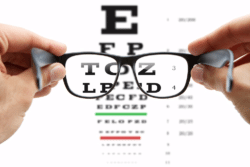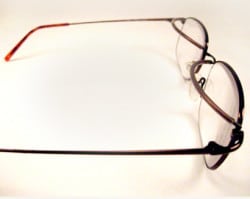Eye Exam FAQs
 Regular eye exams are important to maintaining healthy vision and a happy lifestyle. But many adults are reluctant to get an eye exam for one reason or another. And studies show that 35% of adults skip eye exams entirely just because they don’t think they need one.
Regular eye exams are important to maintaining healthy vision and a happy lifestyle. But many adults are reluctant to get an eye exam for one reason or another. And studies show that 35% of adults skip eye exams entirely just because they don’t think they need one.
At FixMyGlasses.com, we realize knowledge is power. So, if you don’t think you need an eye exam, or you’ve never had an eye exam and you don’t know what to expect, here are the answers to some of the most common questions that might be keeping you from making that eye exam appointment:
#1 What is that contraption with all the lenses?
That giant machine that looks like something out of a sci-fi movie is actually called a Phoropter, or a refractor. It contains different lenses used for sight testing. Or, to put it simply, it determines your eyeglass prescription. It’s also used to measure how your eyes work together – what’s called binocular vision.
#2 What is that annoying puff of air?
The infamous ‘puff of air’ or non-contact tonometer test is actually testing your eyes for signs of Glaucoma. This test measures whether the fluid pressure inside the eyes is within a normal range. Resistance to the air puff indicates the pressure. Alternatively, there is another test called the tonometer test (which is actually more accurate). With this test, drops are used to numb the eye. Then the doctor barely touches the front surface of each eye with an instrument to measure the pressure. See, the puff of air isn’t so bad!
#3 Do doctors still use eye charts?
They do, but gone are the days of the old eye chart posters. Today, most eye doctors use an auto chart projector that has the ability to adjust size, focus and distance of the letters or numbers. Eye charts are used to measure visual acuity. This means testing the sharpness of your vision and your ability to identify objects from a specific viewing distance.
#4 Why does the doctor have to get so close to my face?
A routine eye exam usually involves the doctor looking into the eyes with an instrument about the size of a small flashlight or microscope. This results in a very close encounter. However, this test (called an ophthalmoscopy) is important because it allows the doctor to examine the back of the eyes for any diseases or eye damage.
#5 What does dilation do and what’s the purpose?
Dilation, enlarges the pupils, which allows the doctor to examine the inside of the eyes with different instruments and lights. The pupil-enlarging drops take about 20 to 30 minutes to start working. It’s always a good idea to ask ahead of time, if the doctor plans on dilating your eyes. Since the effects last a few hours, you’ll need to have a ride home and make sure you have sunglasses, since your eyes will be sensitive to light during that time.
#6 I have perfect 20/20 vision. Why do I need an eye exam?
It’s important for adults 40 and older to have eye exams every 2 to 4 years, regardless of their vision status. Regular eye exams are critical for finding eye diseases such as Glaucoma, cataracts, diabetic retinopathy and more. Plus many eye conditions are genetic, or appear later in life.
#7 Is it necessary to shine a light in my eyes?
The pupil adjusts in size depending on the amount of light it receives. By shining a light directly into the eyes, the doctor can watch the reactions of the pupils to light and objects at close distance. At the same time, the doctor looks for other things such as the eyelid position and the condition of the whites of the eyes.
The more you know about the how’s and why’s of an eye exam, the better prepared you’ll be when you walk into the eye doctor’s office. And hopefully knowing some of these eye exam basics will inspire you to make regular eye exams a part of your health routines. After all, your vision depends on regular eye exams and so does your health.
Is there another eye exam question that we missed? If so, send us your question in the comments box. And visit fixmyglasses.com for all your vision and eyeglass needs.






